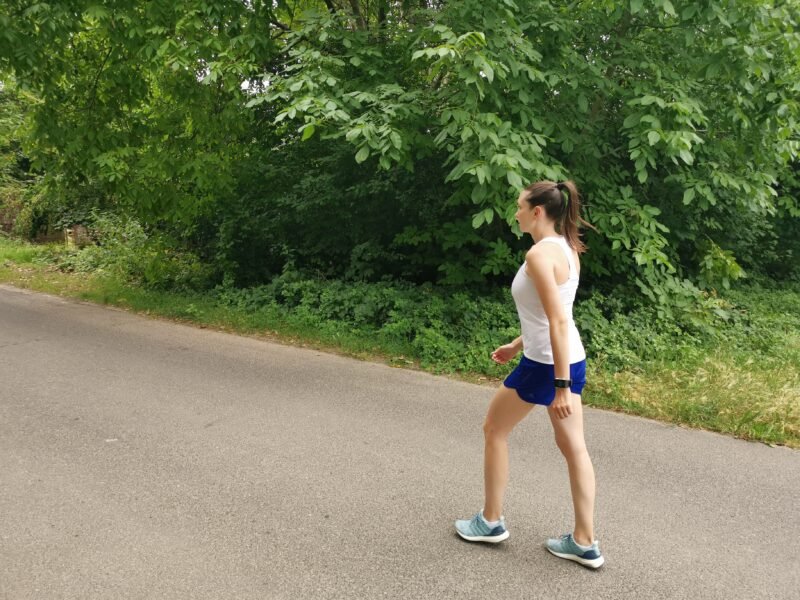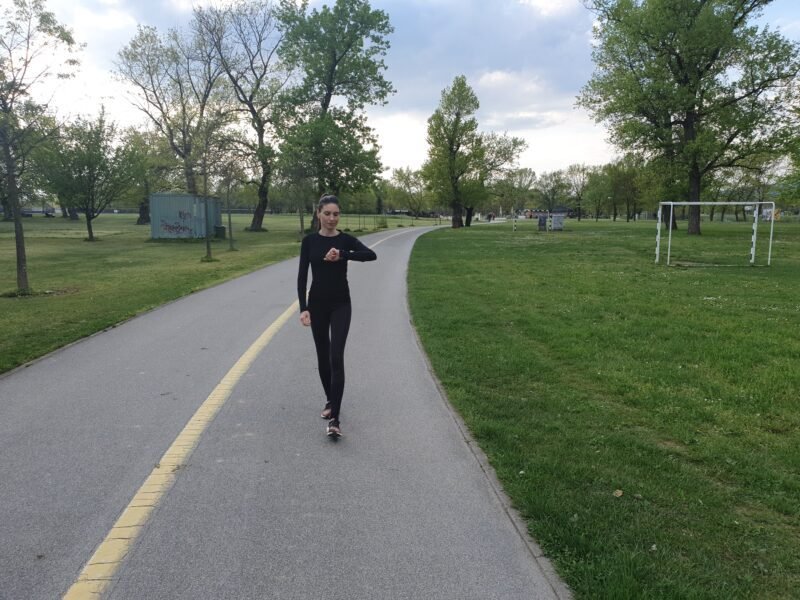How Long Does it Take to Walk 1.5 Miles? (Detailed Answer)
Walking is one of the healthiest and most affordable forms of exercise that provides numerous health benefits.
It’s easy to incorporate into your daily routine, making it an excellent exercise choice for people of all ages and fitness levels.
In this article, you will find out how long it takes to walk 1.5 miles and you will get answers to the most frequently asked questions.
Generally speaking, it takes the average person roughly between 22:30 and 30 minutes to walk 1.5 miles, which means that the average walking speed is between 4 and 3 miles per hour. Numerous factors, such as age, gender, fitness level, and terrain, will affect the final time.
The average walking pace is between 15:00 minutes per mile and 20:00 minutes per mile.
The information in this article is based on research conducted by Schimpl et al.
Depending on the walking pace, the table shows how long it takes to walk 1.5 miles.
| Average walking pace 20:00 min/mi 12:26 min/km 3.00 mph 4.83 kph | Moderate walking pace 17:09 min/mi 10:39 min/km 3.5 mph 5.63 kph | Brisk walking pace 15:00 min/mi 9:19 min/km 4.00 mph 6.44 kph | Fast walking pace 12:00 min/mi 7:27 min/km 5.00 mph 8.05 kph | |
|---|---|---|---|---|
| 1.5 miles in minutes | 30:00 | 25:44 | 22:30 | 18:00 |
You can use my calculator to calculate the time it takes to walk 1.5 miles at a certain pace. You can also calculate what pace you will walk if you walk 1.5 miles in a certain time.

Average time to walk 1.5 miles for women by age
The average time to walk 1.5 miles for women between the ages of 30 to 39 is 30 minutes, which means the average walking speed is 3.00 miles per hour, and the average walking pace is 20:00 minutes per mile.
| Age group | Average time to walk 1.5 miles for women | Average speed (mph) | Average speed (kph) | Average pace (min/mi) | Average pace (min/km) |
|---|---|---|---|---|---|
| 20 – 29 | 30:00 | 3.00 | 4.83 | 20:00 | 12:26 |
| 30 – 39 | 30:00 | 3.00 | 4.83 | 20:00 | 12:26 |
| 40 – 49 | 28:57 | 3.11 | 5.01 | 19:18 | 11:59 |
| 50 – 59 | 30:43 | 2.93 | 4.72 | 20:29 | 12:43 |
| 60 – 69 | 32:30 | 2.77 | 4.46 | 21:40 | 13:28 |
| 70 – 79 | 35:34 | 2.53 | 4.07 | 23:43 | 14:44 |
The table shows the average walking time of 1.5 miles for women with the calculated average walking speed and pace by age group.
Average time to walk 1.5 miles for men by age
The average walking time for 1.5 miles for men between the ages of 30 to 39 is 28:07 minutes, which means the average walking speed is 3.20 miles per hour, and the average walking pace is 18:45 minutes per mile.
| Age group | Average time to walk 1.5 miles for men | Average speed (mph) | Average speed (kph) | Average pace (min/mi) | Average pace (min/km) |
|---|---|---|---|---|---|
| 20 – 29 | 29:36 | 3.04 | 4.89 | 19:44 | 12:16 |
| 30 – 39 | 28:07 | 3.20 | 5.15 | 18:45 | 11:39 |
| 40 – 49 | 28:07 | 3.20 | 5.15 | 18:45 | 11:39 |
| 50 – 59 | 28:07 | 3.20 | 5.15 | 18:45 | 11:39 |
| 60 – 69 | 30:00 | 3.00 | 4.83 | 20:00 | 12:26 |
| 70 – 79 | 31:55 | 2.82 | 4.54 | 21:17 | 13:13 |
The table shows the average walking time for 1.5 miles for men with the calculated average walking speed and pace by age group.

Why is walking good?
Walking is an excellent form of exercise and an important part of a healthy lifestyle.
There are many reasons why walking is good for your health, and these are some of them:
1. Improves cardiovascular health
Regular walking helps lower blood pressure and cholesterol levels.
It also reduces the risk of heart disease and improves circulation.
2. Helps in losing weight
Walking helps burn calories and maintain body weight.
Even low-intensity walking speeds up metabolism and burns calories, making it an effective weight-loss strategy combined with a healthy diet.
Research has shown that 15 minutes of walking can reduce the desire for sweets and even the amount of chocolate you eat in stressful situations.
3. Reduces the risk of chronic diseases
Research has shown that regular walking reduces the risk of chronic diseases such as diabetes, stroke, and certain types of cancer.
Regular walking can help improve blood sugar control, reduce inflammation, and strengthen bones.
4. Strengthens immunity
Walking can help protect you during cold and flu season.
A study of more than 1,000 men and women found that those who walked at least 20 minutes a day, at least 5 days a week, had 43% fewer sick days than those who exercised once a week or less.
And if they did get sick, it was shorter and their symptoms were milder.
5. Improves brain function
Walking has been shown to improve cognitive function and memory.
It can also reduce the risk of age-related dementia.
6. Encourages creative thinking
Walking can help you clear your mind and think creatively.
Research has shown that walking opens up the free flow of ideas and is an easy way to increase creativity and physical activity at the same time.
7. Increases energy
Walking when you’re tired can be a more effective energy booster than drinking a cup of coffee.
Walking increases the flow of oxygen through the body.
It can also increase the levels of hormones that help raise energy levels.
8. Strengthens bones and muscles
Regular walking strengthens your bones and muscles, reducing your risk of osteoporosis and other conditions that affect your mobility.
9. Improves mood and mental health
Walking has been shown to improve mood, and overall mental health as well as reduce stress and anxiety.
Is walking 1.5 miles in 20 minutes good?
To walk 1.5 miles in 20 minutes you need to walk at a speed of 4.34 miles per hour (6.99 kilometers per hour) or at a pace of 13:49 minutes per kilometer.
That’s quite fast for someone who isn’t a speed walker. Most people could hardly walk at that speed.
That’s quite fast for someone who isn’t a speed walker.
How many calories do you burn walking 1.5 miles?
Walking 1.5 miles will burn around 150 calories on average.
The number of calories burned walking 1.5 miles depends on the runner’s weight and shape, walking pace, terrain, and weather conditions.
The heavier you are, the more calories you will burn because you have to carry more weight and work harder to cover the same distance at the same pace.
Example
According to the walking calorie calculator, a person weighing 187 lbs (85 kg) will burn approximately 156 calories walking 1.5 miles at a speed of 3 miles per hour (a pace of 12:26 minutes per mile), while a person weighing 132 lbs (60 kg) will burn approximately 110 calories.
Does walking 1.5 miles burn fat?
Walking 1.5 miles can help you lose fat, but it’s not the only factor to consider. Losing weight requires a combination of a healthy diet and regular exercise.
Walking is a great low-impact aerobic exercise that can help you lose weight, manage stress, and strengthen your heart.
You can start to lose weight and possibly get rid of belly fat by creating a calorie deficit, which is when you burn more calories than you take in.
Additionally, walking uphill or at a different pace can improve the effects of walking.

How many steps to walk 1.5 miles?
It takes approximately 3100 steps to walk 1.5 miles.
To calculate an accurate figure, you need to consider a number of different factors, such as gender, height, weight, stride length, and pace of walking or running.
For example, a shorter person will have to take many more steps to cover the same distance, unlike a taller person.
You can use a calculator to determine exactly how many steps, you have taken in 1.5 miles of walking.
The study calculated the average number of steps that need to be taken per mile while walking or running.
The table shows an overview of the steps required to cross 1.5 miles at a given speed.
| Miles | Average walk (3mph) 20:00 min/mi 12:26 min/km | Brisk walk (4mph) 15:00 min/mi 9:19 min/km |
|---|---|---|
| 1 | 2252 steps | 1935 steps |
| 1.5 | 3378 steps | 2903 steps |
Read more: How Many Steps Are in 1.5 Miles? (Detailed Answer)
Is walking 1.5 miles a day enough?
Walking 1.5 miles a day is a great way to incorporate some physical activity into your routine.
However, whether this will be enough exercise for you depends on your individual goals and fitness level.
It is important to consider the intensity of your walks to determine if this is enough activity for you.
If you are just starting to exercise or lead a sedentary lifestyle, daily walks are a great way to increase your fitness level and gradually increase your activity level.
Over time, you can increase the intensity and duration of your walks to provide new demands on your body.
On the other hand, if your goal is to build strength, increase endurance, or train for a specific sport, walking 1.5 miles a day won’t be enough.
You will need to add other types of training to your routine, such as strength training, running, or other forms of high-intensity exercise, in order to reach your goals.
Info
Although any amount of physical activity is better than none, the American Heart Association recommends that adults get at least 150 minutes of moderate-intensity physical activity at a time, which translates to about 30 minutes a day, 5 days a week. Walking is a moderate-intensity exercise that can help reach these recommendations.
In addition to the recommended 150 minutes of moderate-intensity exercise combined, the American Heart Association also recommends muscle-strengthening activities at least 2 days per week. These activities may include bodyweight exercises, weightlifting, or the use of resistance bands.

Plan your walking routine
Creating a routine for walking or any other activity will make it easier for you to maintain healthy habits.
You’re less likely to skip a workout or simply not have time for it.
Follow these tips to help you plan your walking routine:
1. Set your goals
Before you start walking, it’s important to think about why you want to walk.
Do you want to improve your health, lose weight, reduce stress, or simply enjoy nature?
By knowing your goals, you can adapt the routine to your needs.
2. Choose a walking route
Choose a route that is safe and comfortable for you. You can choose a park, a forest, or a treadmill at the gym, etc.
Keep in mind distance, terrain, and any other factors that may affect your walking.
3. Warm-up
Begin walking with a few minutes of gentle stretching or warm-up exercises to prepare your muscles and joints for the activity ahead.
4. Start slow
Start at a light and comfortable pace and gradually increase your walking speed.
If you are just starting to walk, start with shorter distances and gradually increase the distance over time.
5. Include intervals
Intervals are short bursts of higher-intensity activity distributed with periods of lower-intensity activity.
You can incorporate intervals into your walking routine by picking up your pace for short periods (e.g. 30 seconds to 1 minute) before returning to your normal pace.
6. Cool down
After walking, take a few minutes to cool down and stretch your muscles.
This will prevent injury and promote recovery.
7. Establish a schedule
To make walking a regular habit, make a schedule that suits you.
Aim to walk at least 30 minutes a day, 5 days a week, but of course, adjust this to your goals and fitness level.
8. Track your progress
Tracking your progress can help keep you motivated and you’ll be able to adjust your routine as needed.
You can use an activity app or a simple training log to track your distance, pace, and how you feel while walking.
9. Listen to your body
Most importantly, remember to listen to your body and adjust your routine as needed.
Walking should be a fun and enjoyable activity that you look forward to every day.

Matea Matošević
Hi, I’m Matea! I’m an Olympic Marathon Runner, founder, and writer behind OLYRUN.com. On this site, I provide help in the form of my knowledge and experience to all who love running and active living. Read more…

